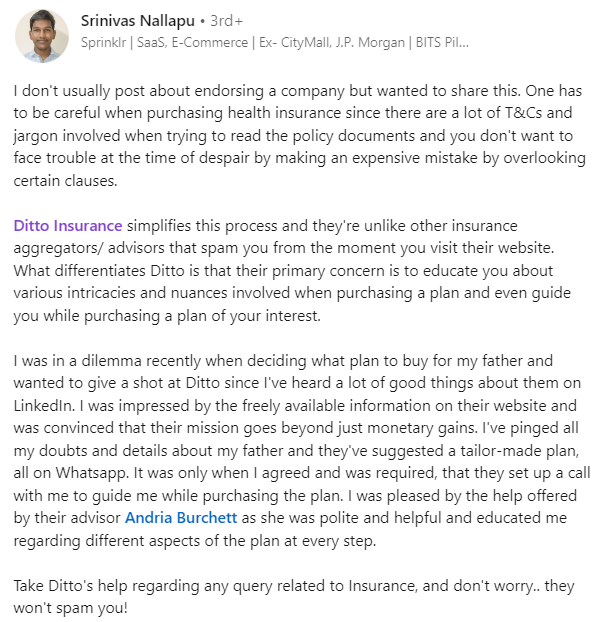What is term insurance with maturity benefit?
Term insurance with maturity benefit is a misnomer. When one reads "maturity," it usually means a payout that's larger than the investment.
But term insurance with maturity benefit usually means a term plan with a Return of Premium. This means, if you survive the policy term, you get 100% of the base premiums (excluding taxes, riders, loading charges).
Introduction
Most people see term insurance as pure protection: you pay premiums for years, and if you outlive the policy term, you get nothing in return. To counter this thought, term insurance with maturity benefit (also called Return of Premium/ROP) was introduced. These offering came with the promise of 100% refund of the base premiums paid if you survive the term.
Sure! this is more reassuring but the refund isn’t an investment return, which means relatively smaller returns. Also, term insurance with maturity benefit, or more accurately, a return of premium, usually costs a lot more than a pure term plan.
At Ditto, we help individuals make smarter insurance choices. So, when it comes to choosing a term plan with maturity benefit, there are some vital points to consider.
In this article, you will learn:
- What is Term Insurance With Maturity Benefit?
- What are the key benefits of term insurance with maturity benefit?
- What are the best term insurance with maturity benefit plans ?
- Who should buy term insurance with maturity benefit?
Heads up! We know that term insurance can be overwhelming – but it doesn’t have to be! Ditto's IRDAI-certified advisors assess your requirements and can help you pick the right policy. And the best part? We don’t spam or pressure you to buy. So book a call now.
What Is Term Insurance With Maturity Benefit : Overview
In term insurance, the only maturity benefit available is Return of Premium (ROP). Other so-called “maturity” elements, like bonuses, loyalty additions, cash values, or fund values are exclusive to savings/investment products (endowment, participating/whole-life, ULIPs), not to term plans.
Now, Return of Premium (ROP) means if you survive the policy term, the insurer refunds 100% of the base premiums paid (excluding rider premiums, loadings, modal charges, and any add-ons). There’s no investment return or bonus attached.
In short:
- Term insurance with ROP gives protection and refund of base premiums at maturity (no bonuses or extra cash).
- Endowment/Participating/ULIP offers protection and savings/investment benefits (with different pricing and goals).
Note: Any lapses, paid-up status, or surrenders can reduce/void the refund, and if a death claim is paid during the term, the maturity refund does not apply.
Term Insurance with Maturity Benefit: Use Case
If one pays a base annual premium of ₹12,000 for 30 years, the final refund will be ₹3,60,000 (12,000 × 30) at maturity (no additional interest or extra pay).
Most Indian insurers sell “term insurance with maturity benefit” as a Return of Premium (ROP) option. But In term plans, the maturity amount is the refund of base premiums (with taxes/riders excluded).
Term Insurance with Maturity Benefit: Plans
Term ROPs are non-participating and attract no bonuses or dividends. Think of plans like HDFC Life Click 2 Protect Super or Max Life Smart Secure Plus for insurance. The ROP variants of plans like SBI Life eShield and LIC Jeevan Kiran are also non-linked, non-participating.
A rare plan in this category is Tata AIA Sampoorna Raksha Supreme Life Plus that promises up to 105% of Total Premiums Paid at maturity, but it’s still not a bonus. Put simply, if a plan mentions “bonus” or “refund value,” it’s simply endowment or ULIP, not a term insurance.

Key Features of Term Insurance with Maturity Benefit
Premiums refunded at maturity
Many view this as a forced-savings feature that provides a lump sum at the end of the term.
Access to multiple add-ons (riders)
Typically allows riders such as Critical Illness (CI), Accidental Death Benefit (ADB), Waiver of Premium (WOP), and disability or life-stage options, for an additional cost.
Standard policy rights
Similar to pure term insurance, ROP plans generally include a free-look period (usually 30 days from receipt of the policy document), grace period, revival provisions, and surrender/paid-up rules as per the policy terms and conditions.
Tax benefits (under old regime)
Premiums may be eligible for deductions under Section 80C (up to ₹1.5 lakh per financial year under the old tax regime). Maturity/death benefits may be exempt under Section 10(10D), subject to prevailing conditions.
Pros and Cons Of Term Insurance With Maturity Benefit
Before you say yes to term insurance with maturity benefits, here’s a closer look at the benefits and drawbacks.
Advantages of Term Insurance with Maturity Benefit
As discussed above, term insurance with maturity benefit comes with a return of base premiums, useful add-ons, built-in savings, and tax benefits.
Drawbacks of Term Insurance With Maturity Benefit
- ROP term plans are significantly more expensive than pure term plans: The extra money you pay can upset your budget leaving you with a smaller sum insured than you need.
- For instance, the 1st year premium of the non-ROP variant of HDFC Life's Click 2 Protect Supreme (till age 60) for a 30-year old, non-smoker in a Tier I city is ₹10,543, while the ROP variant costs ₹30,587.
- Nothing extra is refunded beside the premiums: With ROP plans, you only get back the premiums you paid without any interest. For practical reasons, it’s a bad investment.
- Let’s say you could have bought a term plan for an annual premium of ₹12,000. But instead, you opt for a ROP plan paying ₹28,000/yr (extra ₹16,000).
- At the end of the term (say 30 years), the refund amount you get is ₹28,000 × 30= ₹8.40 lakh (only the premium, nothing else).
- If the extra ₹16,000 was invested in a mutual fund with 8% returns for 30 years, it would’ve fetched ₹18.12 lakhs!
- You run the risk of being under-insured: Many people compromise on their cover to afford a term insurance plan with maturity benefit. For example, settling for ₹50L cover instead of ₹1–2Cr that they actually need.
- Missing on opportunity cost and tax benefits: The money you pay into a Return of Premium (ROP) term plan isn’t compounding anywhere else. The death benefit, however, remains tax-free.
Term Insurance with Maturity Benefit: Best Plans in India 2025
Term Insurance with Maturity Benefit vs Zero-Cost Term Plans
While understanding term insurance with maturity benefit is important, comparing it with zero-cost term plans reveals a more flexible and cost-effective approach. Let’s see how these options differ and which suits your financial goals better.
For higher returns (8-12% equity, 6-7% debt), greater liquidity, and portfolio flexibility, combine a low-cost term plan with separate investments (SIPs, PPF, NPS, fixed deposits). This will save you from locking funds in endowment plans.
Term Plan with ROP (TROP) vs Term + SIP: Which Is Smarter?
Why Term + SIP Wins:
- Growth: Even 6% returns beat TROP; 12% gives 4x more.
- Liquidity: Access funds anytime vs. locked 30 years.
- Inflation Protection: Investments outpace inflation; TROP doesn't.
- Flexibility: Adjust portfolio per life goals; TROP is rigid.
Why Choose Ditto for Your Term Life Insurance?
At Ditto, we’ve helped 8,00,000+ customers find the right insurance plan by matching their unique needs and budget. That’s why customers like Srinivas trust and recommend us every time.

- No-Spam & No Salesmen
- Rated 4.9/5 on Google Reviews by 5,000+ happy customers
- Backed by Zerodha
- 100% Free Consultation
You can book a FREE consultation. Slots are running out, so make sure you book a call now!
Term Insurance with Maturity Benefit: Ditto’s Take
Honestly, a ROP term plan refunds base premiums if the insured outlives the maturity period. However, it costs way more than a pure term plan. For most buyers, the best option is to get a pure term plan and invest the extra premium into mutual funds or other market-linked instruments for better, long-term value. Here’s Ditto’s 5-step checklist to help you.
- Get two quotes with the same cover and term; Pure Term and TROP.
- Note the yearly premium gap.
- Invest the same amount (i.e., gap) in a simple SIP (keep it conservative at 6-8%).
- Compare the future value of the SIP to the TROP refund.
- Choose the option with adequate cover.
Botton line? TROP makes sense if you need a money-back promise without cutting your cover. But if the higher premium reduces the sum assured you actually need, skip it.
Frequently Asked Questions
Do all term plans have maturity benefits?
No. Pure term has no survival payout. Only ROP variants refund base premiums at maturity.
What exactly gets refunded under ROP?
Typically, 100% of base premiums paid are refunded excluding the taxes/rider charges/loadings. Refer to your policy brochure for details.
Is ROP better than a pure term?
Well, ROP is costlier and the maturity refund is low-yield. Pure term is cheaper and lets you invest the difference.
Is Zero-Cost the same as ROP?
No. Zero-Cost allows a pre-defined early exit with a refund but ROP refunds only at maturity if one survives the full term.
Should you buy term insurance with maturity benefit?
We don’t recommend buying term insurance with maturity benefit unless the money-back feature helps you stay insured without reducing the cover. But for most buyers getting a pure term plan and investing the difference is a better option for long term value and protection.
Last updated on:









